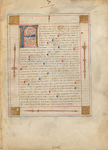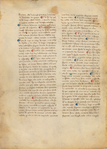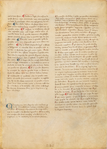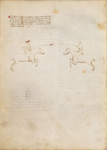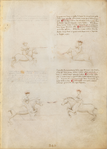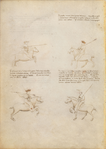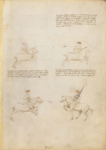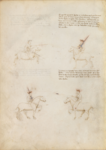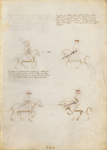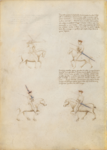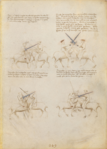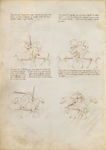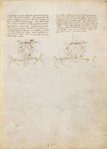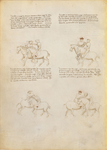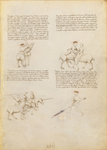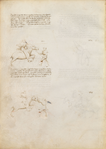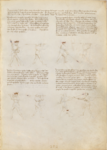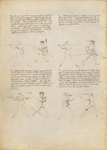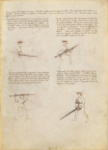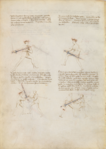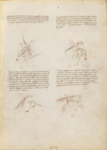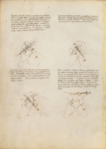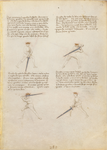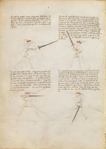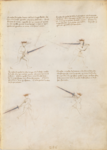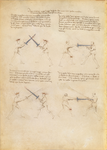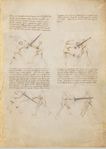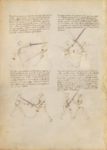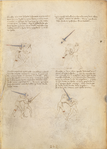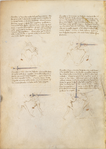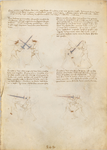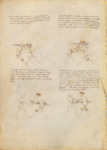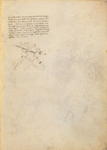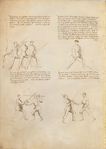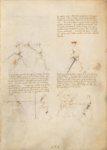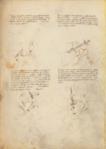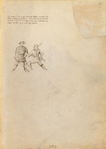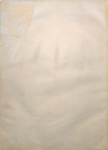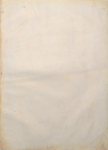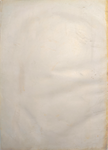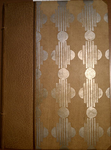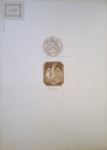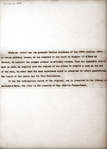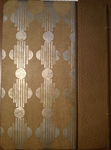|
|
You are not currently logged in. Are you accessing the unsecure (http) portal? Click here to switch to the secure portal. |
Difference between revisions of "Trattato della scherma (MS M.383)"
| Line 48: | Line 48: | ||
'''''Fior di Battaglia''''' ("The Flower of Battle", B1.370.A MS M.0383) is a contemporary copy<ref>It does not match the descriptions of any of the fencing manuscripts in the d'Este library in the 15th century.</ref> of an [[nationality::Italian]] [[fencing manual]] authored by [[Fiore de'i Liberi]], probably created some time in or before 1404. The original currently rests in the holdings of the [[Morgan Library & Museum]] in New York City, New York. MS M.383 is written on vellum in a modern biding in a neat [[humanist]] script; the illustrations are inked sketches with gold leafing on the crowns and garters and silver enamel on the metallic elements of the weapons (this has oxidized to a very dark grey over the centuries). This manuscript is typically referred to as the '''Morgan''' (or sometimes the Pierpont Morgan or PML). | '''''Fior di Battaglia''''' ("The Flower of Battle", B1.370.A MS M.0383) is a contemporary copy<ref>It does not match the descriptions of any of the fencing manuscripts in the d'Este library in the 15th century.</ref> of an [[nationality::Italian]] [[fencing manual]] authored by [[Fiore de'i Liberi]], probably created some time in or before 1404. The original currently rests in the holdings of the [[Morgan Library & Museum]] in New York City, New York. MS M.383 is written on vellum in a modern biding in a neat [[humanist]] script; the illustrations are inked sketches with gold leafing on the crowns and garters and silver enamel on the metallic elements of the weapons (this has oxidized to a very dark grey over the centuries). This manuscript is typically referred to as the '''Morgan''' (or sometimes the Pierpont Morgan or PML). | ||
| − | The treatise itself is the briefest known version of Fiore's work, containing only 19 folia (all individual leaves). It has a preface in Italian and one to four illustrated figures per page in the main body; the figures are accompanied by descriptive paragraphs set in poor Italian verse which are nevertheless fairly clear and informative, and generally comparable to that of the [[ | + | The treatise itself is the briefest known version of Fiore's work, containing only 19 folia (all individual leaves). It has a preface in Italian and one to four illustrated figures per page in the main body; the figures are accompanied by descriptive paragraphs set in poor Italian verse which are nevertheless fairly clear and informative, and generally comparable to that of the [[Fior di Battaglia (MS Ludwig XV 13)|MS Ludwig ⅩⅤ 13]] (excepting differences in spelling), though at times they include additional explanation. The artwork is reminiscent of the work of [[Altichiero da Zevio]], but given the timeline it would more likely be the work of an artist influenced by him (or a manuscript produced fairly early in Fiore's career). |
| − | The MS M.383 was almost certainly longer when it was first written; its text makes reference to sections on poleaxe, dagger, and grappling which are not present in the book's current state, as well as a certain play of the sword in one hand which is likewise missing from that section. Furthermore, the manuscript is composed of individual cut leaves rather than quires of bifolia, which means that there is no indicator of the original order of the surviving pages.<ref>The description in this section is derived from an examination of the manuscript by [[Michael Chidester]]; the presumed date is based on the fact that it seems to be related in some fashion to the [[Fior di Battaglia (MS Ludwig XV 13)|MS Ludwig | + | The MS M.383 was almost certainly longer when it was first written; its text makes reference to sections on poleaxe, dagger, and grappling which are not present in the book's current state, as well as a certain play of the sword in one hand which is likewise missing from that section. Furthermore, the manuscript is composed of individual cut leaves rather than quires of bifolia, which means that there is no indicator of the original order of the surviving pages.<ref>The description in this section is derived from an examination of the manuscript by [[Michael Chidester]]; the presumed date is based on the fact that it seems to be related in some fashion to the [[Fior di Battaglia (MS Ludwig XV 13)|MS Ludwig ⅩⅤ 13]], which is presumed to date to 1404.</ref> |
== Provenance == | == Provenance == | ||
| Line 177: | Line 177: | ||
* [[Fiore de'i Liberi|dei Liberi, Fiore]]; Leoni, Tommaso. ''Fiore de’ Liberi’s Fior di Battaglia''. 1st ed. [http://www.lulu.com/product/paperback/fiore-de-liberis-fior-di-battaglia/5364635 Lulu.com], 2009. 2nd ed. Wheaton, IL: [[Freelance Academy Press]], 2012. | * [[Fiore de'i Liberi|dei Liberi, Fiore]]; Leoni, Tommaso. ''Fiore de’ Liberi’s Fior di Battaglia''. 1st ed. [http://www.lulu.com/product/paperback/fiore-de-liberis-fior-di-battaglia/5364635 Lulu.com], 2009. 2nd ed. Wheaton, IL: [[Freelance Academy Press]], 2012. | ||
| − | * [[Fiore de'i Liberi|dei Liberi, Fiore]]; [[Marco Rubboli|Rubboli, Marco]]; [[Luca Cesari|Cesari, Luca]] (in Italian). ''Flos Duellatorum. Manuale di Arte del Combattimento del | + | * [[Fiore de'i Liberi|dei Liberi, Fiore]]; [[Marco Rubboli|Rubboli, Marco]]; [[Luca Cesari|Cesari, Luca]] (in Italian). ''Flos Duellatorum. Manuale di Arte del Combattimento del ⅩⅤ secolo''. Rome: [[Il Cerchio Iniziative Editoriali]], 2002. ISBN 88-8474-023-1. |
| − | * Malipiero, Massimo (in Italian). ''Il Fior di battaglia di Fiore dei Liberi da Cividale: Il Codice Ludwing | + | * Malipiero, Massimo (in Italian). ''Il Fior di battaglia di Fiore dei Liberi da Cividale: Il Codice Ludwing ⅩⅤ 13 del J. Paul Getty Museum''. Udine: Ribis, 2006. ISBN 88-7445-035-4. |
* [[Luigi Zanutto|Zanutto, Luigi]] (in Italian). ''[http://www.historicalfencing.org/PDF/Zanutto-Fiore%20da%20Premariacco.pdf Fiore di Premariacco ed I Ludi e Le Feste Marziali e Civili in Friuli]''. Udine: D. Del Bianco, 1907. | * [[Luigi Zanutto|Zanutto, Luigi]] (in Italian). ''[http://www.historicalfencing.org/PDF/Zanutto-Fiore%20da%20Premariacco.pdf Fiore di Premariacco ed I Ludi e Le Feste Marziali e Civili in Friuli]''. Udine: D. Del Bianco, 1907. | ||
Revision as of 17:46, 16 April 2021
| Il Fior di Battaglia | |||||
|---|---|---|---|---|---|
| B1.370.A MS M.0383, Morgan Library & Museum New York City, New York | |||||
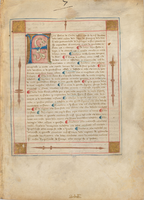 Title page, fol. 1r | |||||
| |||||
| |||||
| Type | |||||
| Date | before 1404 (?) | ||||
| Place of origin | Milan, Italy | ||||
| Language(s) | Venetian (Italian) | ||||
| Author(s) | Fiore de'i Liberi | ||||
| Scribe(s) | Unknown | ||||
| Illustrator(s) | Altichiero da Zevio (or follower) | ||||
| Material | Vellum, in a modern binding | ||||
| Size | 20 folia (195 mm × 277 mm) | ||||
| Format | Double-sided; four illustrations per side, with text above | ||||
| External data | Library catalog entry | ||||
| Treatise scans |
| ||||
Fior di Battaglia ("The Flower of Battle", B1.370.A MS M.0383) is a contemporary copy[1] of an Italian fencing manual authored by Fiore de'i Liberi, probably created some time in or before 1404. The original currently rests in the holdings of the Morgan Library & Museum in New York City, New York. MS M.383 is written on vellum in a modern biding in a neat humanist script; the illustrations are inked sketches with gold leafing on the crowns and garters and silver enamel on the metallic elements of the weapons (this has oxidized to a very dark grey over the centuries). This manuscript is typically referred to as the Morgan (or sometimes the Pierpont Morgan or PML).
The treatise itself is the briefest known version of Fiore's work, containing only 19 folia (all individual leaves). It has a preface in Italian and one to four illustrated figures per page in the main body; the figures are accompanied by descriptive paragraphs set in poor Italian verse which are nevertheless fairly clear and informative, and generally comparable to that of the MS Ludwig ⅩⅤ 13 (excepting differences in spelling), though at times they include additional explanation. The artwork is reminiscent of the work of Altichiero da Zevio, but given the timeline it would more likely be the work of an artist influenced by him (or a manuscript produced fairly early in Fiore's career).
The MS M.383 was almost certainly longer when it was first written; its text makes reference to sections on poleaxe, dagger, and grappling which are not present in the book's current state, as well as a certain play of the sword in one hand which is likewise missing from that section. Furthermore, the manuscript is composed of individual cut leaves rather than quires of bifolia, which means that there is no indicator of the original order of the surviving pages.[2]
Contents
Provenance
The known provenance of the MS M.383 is:[3]
- Probably written between some time in the first decade of the 1400s.
- before 1474 – owned by Niccolò Marcello di Santa Marina of Venice.
- ca. 1699 – gifted to Apostolo Zeno (1668-1750), who created a copy of the preface.
- before 1780 – it occupied ff 241-259 of a larger collective binding titled, Arte di armeggiare a piedi ed acavallo (codex Soranzo MCCLXI) in the Biblioteca Soranzo in Venice (Library of Jacopo Soranzo, Venetian senator, 18th century). The other contents of this codex are unknown.
- 1780-1835 – the collection of the Venetian former Jesuit Matteo Luigi Canonici (1727-c.1806) (sold London, Sotheby's, June 15, 1836, no. 40).
- 1835-1903 – owned by Rev. Walter Sneyd of Bagington Rectory, Coventry (sold London, Sotheby's, Dec. 19, 1903, no. 720).
- 1903-1909 – owned by Tammaro de Marinis (catalog 8, 1908, plate 9).
- 1909-1913 – owned by John Pierpont Morgan.
- 1913-1924 – owned by John Pierpont Morgan, Jr. (donated 1924).
- 1924-present – held by the Morgan Library & Museum. Current binding by J. Clarke.
Contents
| 1r - 2r | Preface by Fiore de'i Liberi |
|---|---|
| 2v - 8r | Mounted fencing by Fiore de'i Liberi |
| 8rv | Spear vs. cavalry by Fiore de'i Liberi |
| 9rv | Spear by Fiore de'i Liberi |
| 10r - 11v | Sword in Armor by Fiore de'i Liberi |
| 12r - 16v | Sword in two hands by Fiore de'i Liberi |
| 17r, 18rv | Sword vs. dagger by Fiore de'i Liberi |
| 17v, 19r | Sword in one hand by Fiore de'i Liberi |
| 18r | Sword vs. spear by Fiore de'i Liberi |
| 18r | Spear and dagger vs. spear by Fiore de'i Liberi |
| 19v - 20v | Blank |
Gallery
Current manuscript
MS M.383 consists of twenty individual cut leaves rather than quires of bifolia, and the current sequence of leaves is probably not original; for a speculative reconstruction of its original state, see Fior di Battaglia (MS M.383)/Reconstruction. While it seems likely that there are at least two missing leaves, there's no evidence upon which to speculate meaningfully about the original quire structure (the Getty manuscript, for example, has a wildly variable structure).
This manuscript was unbound in 2016 for photography and conservation, and it has not yet been rebound.
Previous binding
As indicated above, the original binding of the manuscript was lost by the 18th century. It was most recently rebound in the early 20th century after being acquired by J. P. Morgan, as pictured here, but this cover was subsequently discarded in 2016.
Additional Resources
- dei Liberi, Fiore; Leoni, Tommaso. Fiore de’ Liberi’s Fior di Battaglia. 1st ed. Lulu.com, 2009. 2nd ed. Wheaton, IL: Freelance Academy Press, 2012.
- dei Liberi, Fiore; Rubboli, Marco; Cesari, Luca (in Italian). Flos Duellatorum. Manuale di Arte del Combattimento del ⅩⅤ secolo. Rome: Il Cerchio Iniziative Editoriali, 2002. ISBN 88-8474-023-1.
- Malipiero, Massimo (in Italian). Il Fior di battaglia di Fiore dei Liberi da Cividale: Il Codice Ludwing ⅩⅤ 13 del J. Paul Getty Museum. Udine: Ribis, 2006. ISBN 88-7445-035-4.
- Zanutto, Luigi (in Italian). Fiore di Premariacco ed I Ludi e Le Feste Marziali e Civili in Friuli. Udine: D. Del Bianco, 1907.
References
- ↑ It does not match the descriptions of any of the fencing manuscripts in the d'Este library in the 15th century.
- ↑ The description in this section is derived from an examination of the manuscript by Michael Chidester; the presumed date is based on the fact that it seems to be related in some fashion to the MS Ludwig ⅩⅤ 13, which is presumed to date to 1404.
- ↑ Based in part on "Curatorial description". CORSAIR Collection Catalog. Morgan Library & Museum. Retrieved 12 November 2012.
Copyright and License Summary
For further information, including transcription and translation notes, see the discussion page.
| Work | Author(s) | Source | License |
|---|---|---|---|
| Images | Morgan Library & Museum | Morgan Library & Museum | |
| Transcription | Michael Chidester | Index:Fior di Battaglia (MS M.383) |

